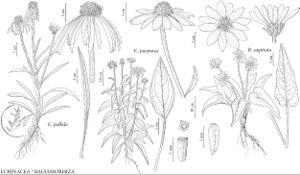Echinacea
Methodus, 591. 1794.
| Taxon | Illustrator ⠉ | |
|---|---|---|
 | Echinacea pallida Echinacea purpurea Balsamorhiza sagittata | John Myers John Myers John Myers |
Perennials, to 140 cm (caudices vertical or horizontal; plants usually taprooted, fibrous-rooted in E. purpurea). Stems erect, unbranched or ± branched (glabrous or hairy, hairs appressed, ascending, or spreading, uniseriate). Leaves basal and cauline; alternate; petiolate (at least basal and proximal cauline, petioles progressively shorter distally); blades (1-nerved, 3-nerved, or 5-nerved) linear to lanceolate or elliptic to ovate (distal smaller), bases mostly attenuate (decurrent on petioles) to cuneate, sometimes rounded or cordate, margins usually entire, sometimes dentate or serrate, faces usually hairy (hairs uniseriate, usually with 1–4 rings of cells surrounding bases), sometimes glabrate or glabrous. Heads radiate, borne singly (on relatively long peduncles). Involucres crateriform to hemispheric, 12–40 mm diam. Phyllaries persistent, 15–50 in 2–4 series (spreading, recurved, or reflexed, linear or lanceolate to ovate, subequal to unequal, mostly herbaceous, apices mostly attenuate, abaxial faces usually hairy, sometimes glabrate or glabrous). Receptacles hemispheric to conic, paleate (paleae orange to reddish purple distally, surpassing disc corollas, bases partially surrounding cypselae, bodies keeled, apices abruptly constricted to awnlike tips; discs 10–45 × 15–40 mm). Ray-florets 8–21, neuter; corollas dark purple to pale-pink, white, or yellow (tubes glabrous or sparsely hairy, laminae spreading, reflexed, or drooping, linear to elliptic or obovate, abaxial faces glabrous or moderately hairy). Disc-florets 200–300+, bisexual, fertile; corollas pinkish, greenish, reddish purple, or yellow, tubes shorter than throats (often sparsely hairy), lobes 5 (erect or spreading to recurved), triangular (pollen usually yellow, usually white in E. pallida). Cypselae (tan or bicolored with dark-brown band distally) 3-angled or 4-angled (faces smooth to finely tuberculate, glabrous or sparsely hairy); pappi persistent, ± coroniform (with 0–4 ± prominent teeth). x = 11.
Distribution
e, c North America
Discussion
Species 9 (9 in the flora).
In keys and descriptions, “discs” refers to receptacles at late flowering with paleae and florets included in assessing shapes and in measurements of lengths and diameters.
Selected References
Lower Taxa
Key
| 1 | Basal leaves: blades (1–)5–12 cm wide, bases rounded to cordate (plants fibrous rooted) | Echinacea purpurea |
| 1 | Basal leaves: blades 0.5–4(–6.5) cm wide, bases usually cuneate to attenuate, sometimes rounded (E. laevigata) (plants taprooted) | > 2 |
| 2 | Herbage (stems and leaves) glabrate (and glaucous); basal leaf blades 3–6.5 cm wide, margins usually serrate or dentate | Echinacea laevigata |
| 2 | Herbage usually sparsely to densely hairy, rarely glabrous; basal leaf blades 0.5–4 cm wide, margins usually entire | > 3 |
| 3 | Hairs (stems, leaves, and peduncles) appressed to ascending | > 4 |
| 3 | Hairs (stems, leaves, and peduncles) spreading | > 6 |
| 4 | Rays yellow; s, c Missouri, n Arkansas (Ozark region) | Echinacea paradoxa |
| 4 | Rays pale pink, dark pink, purple, or white; Kansas, Oklahoma, and Texas | > 5 |
| 5 | Ray laminae 19–35 mm; ray cypselae glabrous distally; e Kansas, Oklahoma, and Texas | Echinacea atrorubens |
| 5 | Ray laminae 30–70 mm; ray cypselae hairy distally (at least on angles); s, c Oklahoma (Arbuckle Mountain region) | Echinacea paradoxa |
| 6 | Ray laminae 15–40 mm | > 7 |
| 6 | Ray laminae 40–90 mm | > 8 |
| 7 | Discs 20–35 mm diam. (herbage induments relatively harsh); widespread, plains,w North America | Echinacea angustifolia |
| 7 | Discs 15–25 mm diam. (herbage induments relatively soft); c Tennessee | Echinacea tennesseensis |
| 8 | Discs subspheric, 15–30 × 20–30 mm; paleae 8–11 mm, tips purple, rounded (sw Arkansas, w Louisiana, se Oklahoma, e Texas) | Echinacea sanguinea |
| 8 | Discs conic to hemispheric, 20–40 × 20–37 mm; paleae 9–14 mm, tips pinkish to purple, sharp-pointed | > 9 |
| 9 | Ray corollas pink to reddish purple, 3–4 mm wide; pollen usually white, sometimes lemon yellow; cypselae glabrous | Echinacea pallida |
| 9 | Ray corollas rose to pink or white, 4–7 mm wide; pollen yellow; cypselae (rays) hairy (n Arkansas, se Missouri, eastward) | Echinacea simulata |
"broader" is not a number.